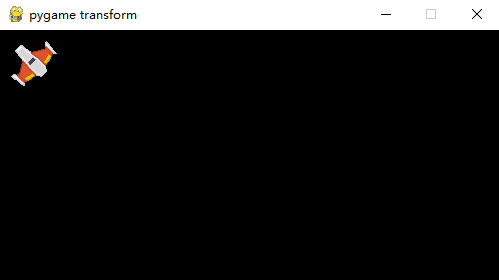Pygame transform模块入门介绍
目录
- 简介
- 函数说明
简介
pygame模块用于变换Surface,Surface变换是一种移动或调整像素大小的操作。所有这些函数都是对一个Surface进行操作, 并将结果返回一个新的Surface。
有些变换被认为是破坏性的。这意味着每次执行这些变换都会丢失像素数据。常见的例子是调整大小和旋转。出于这个原因, 重新变换原始Surface比继续多次变换图像要好。(例如, 假设您正在制作一个弹跳弹簧的动画, 它将膨胀和收缩。如果您将尺寸变化逐步应用于之前的图像, 您将失去细节。相反, 总是从原始图像开始, 然后缩放到所需的大小。)
下面看一组简单的演示示例:
import pygame
#引入pygame中所有常量,比如 QUIT
from pygame.locals import *
pygame.init()
screen = pygame.display.set_mode((500,250))
pygame.display.set_caption('pygame transform')
#加载一张图片(455*191)
image_surface = pygame.image.load("sky_shoot/img/playerShip1_orange.png").convert()
image_new = pygame.transform.scale(image_surface,(100,75))
# 查看新生成的图片的对象类型
#print(type(image_new))
# 对新生成的图像进行旋转至45度
image_1 =pygame.transform.rotate(image_new,45)
# 使用rotozoom() 旋转 0 度,将图像缩小0.5倍
image_2 = pygame.transform.rotozoom(image_1,0,0.5)
while True:
for event in pygame.event.get():
if event.type == QUIT:
exit()
# 将最后生成的image_2添加到显示屏幕上
screen.blit(image_2,(0,0))
pygame.display.update()
程序的运行结果如下:

函数说明
- pygame.transform.flip()
翻转Surface
flip(Surface,xbool,ybool)->Surface
此功能可以垂直、水平或同时翻转一个Surface。翻转Surface是非破坏性的, 并返回一个具有相同尺寸的新Surface。
- pygame.transform.scale()
调整到新的分辨率
scale(Surface, (width, height), DesSurface=None)->Surface
将Surface调整为新的分辨率。这是一个不对结果进行采样的快速缩放操作。可以使用一个可选的目标Surface, 而不是让它创建一个新的Surface。如果你想重复缩放一些东西, 这样会更快。但是, 目标Surface的大小必须与传入的(宽、高)相同。而且目标Surface必须是相同的格式。
- pygame.transform.rotate()
rotate(surface, angle) -> Surface
未经过滤的逆时针旋转。角度参数代表度数, 可以是任何浮点值。负的角度值将顺时针旋转。除非以90度为增量旋转, 否则图像将被垫大以保持新的尺寸。如果图像有象素, 填充区域将是透明的。否则, pygame将选择与Surface colorkey或topleft像素值相匹配的颜色。
- pygame.transform.rotozoom()
rotozoom(surface, angle, scale) -> Surface
这是一个结合了缩放和旋转的变换。得到的Surface是一个过滤后的32位Surface。刻度参数是一个浮点数, 将乘以当前的分辨率。角度参数是一个浮点值, 代表要旋转的逆时针度数。负的旋转角度将顺时针旋转。
- pygame.transform.scale2x()
scale2x(surface, dest_surface=None) -> Surface
这将返回一个新的图像, 其大小是原来的两倍。它使用AdvanceMAME Scale2X算法, 对位图图形进行 "无锯齿 "缩放。这实际上只对纯色的简单图像有影响。在摄影和反锯齿图像上, 它将看起来像一个普通的未经过滤的规模。可以使用一个可选的目标Surface, 而不是让它创建一个新的Surface。如果您想重复缩放某些Surface, 这样做会更快。但是目标Surface的大小必须是传入的源Surface的两倍。而且目标Surface必须是相同的格式。
- pygame.transform.smoothscale()
平滑地缩放一个任意大小的Surface。
smoothscale(surface, size, dest_surface=None) -> Surface
使用两种不同的算法之一来按需缩放输入Surface的每个尺寸。为了缩小,输出像素是它们覆盖的颜色的面积平均值。为了扩展,使用双线性滤波器。对于x86-64和i686体系结构,包含了优化的 MMX 例程,它们的运行速度比其他计算机类型快得多。大小是2个数字的序列(宽度,高度)。此功能仅适用于24位或32位Surface。如果输入Surface位深度小于24,则将引发异常。pygame 1.8中的新功能。
- pygame.transform.get_smoothscale_backend()
返回正在使用的smoothscale滤波器版本。‘GENERIC’, ‘MMX’, 或 ‘SSE’。
get_smoothscale_backend() -> string
显示平滑缩放是否正在使用 MMX 或 SSE 加速。如果没有可用的加速度,则返回“ GENERIC”。对于x86处理器,要在运行时确定要使用的加速级别。该函数用于pygame的测试和调试。
- pygame.transform.set_smoothscale_backend()
将平滑尺度过滤器版本设置为:“GENERIC”、"MMX "或 "SSE "之一。‘GENERIC’, ‘MMX’, 或 ‘SSE’.
set_smoothscale_backend(backend) -> None
设置平滑比例加速度。采用字符串参数。值“ GENERIC”将关闭加速。“ MMX” 仅使用 MMX 指令。'SSE’也允许 SSE 扩展。如果当前处理器无法识别或不支持类型,则会引发值错误。这个函数是为了pygame测试和调试而提供的。如果 smoothscale 导致无效指令错误, 那么这是一个 pygame/SDL 错误, 应该被报告。仅将此函数用作临时修复。
- pygame.transform.chop()
获取一个去掉内部区域的图像副本。
chop(surface, rect) -> Surface
提取图像的一部分。删除给定矩形区域周围的所有垂直和水平像素。然后将角区域(矩形的对角线)合并。此操作不会改变原始图像)。NOTE :如果需要“裁切”来返回rect中图像的一部分,则可以使用rect剪切到新Surface或复制次Surface。
- pygame.transform.laplacian()
寻边
laplacian(surface, dest_surface=None) -> Surface
使用大写字母算法来寻找Surface的边缘。pygame 1.8中的新功能。
- pygame.transform.average_surfaces()
从许多Surface中找出平均Surface。
average_surfaces(surfaces, dest_surface=None, palette_colors=1) -> Surface
取一个Surface的序列, 并返回每个Surface的平均颜色的Surface。palette_colors-如果为真, 我们对调色板中的颜色进行平均, 否则我们对像素值进行平均。如果Surface实际上是灰度颜色, 而不是调色板颜色, 这很有用。注意, 这个函数目前不能正确处理使用Surface的调色板。pygame 1.8中的新功能。pygame 1.9的新功能: palette_colors 参数
- pygame.transform.average_color()
找到Surface的平均颜色
average_color(surface, rect=None) -> Color
查找Surface或矩形指定的Surface区域的平均颜色, 并以颜色返回。
- pygame.transform.threshold()
查找Surface中哪些像素和多少像素在 "search_color "或 "search_surf "的阈值之内。
threshold(dest_surface, surface, search_color, threshold=(0, 0, 0, 0), set_color=(0, 0, 0, 0), set_behavior=1, search_surf=None, inverse_set=False) -> num_threshold_pixels
这个多功能的函数可以用于在接近 "search_color "的 "surf "中查找颜色, 或者接近单独的 "search_surf "中的颜色。它也可以用来将匹配或不匹配的像素转移到’dest_surf’中。默认情况下, 它将’dest_surf’中所有不在阈值内的像素都改为set_color。
如果inverse_set设置为True, 则在阈值内的像素会被改变为set_color。如果给定了可选的’search_surf’Surface, 它被用来针对而不是指定的’set_color’进行阈值化。也就是说, 它将在’surf’中找到每一个在’search_surf’相同坐标的像素的’阈值’内的像素。
Parameters:
dest_surf(pygame.Surface或**None)-我们正在更改的Surface。参见“ set_behavior”。如果计数(set_behavior为0),则应为None。
surf(pygame.Surface)-我们正在查看的Surface。
search_color(pygame.Color)-我们正在寻找的颜色。
threshold(pygame.Color)-在距search_color(或search_surf)距离之内。您可以使用阈值(r,g,b,a),其中r,g,b可以具有不同的阈值。因此,您可以根据需要使用r阈值40和蓝色阈值2。
set_color(pygame.Color或**None)-我们在dest_surf中设置的颜色。
set_behavior(int)-set_behavior=1 (默认)。dest_surface中的像素将被改为’set_color’。set_behavior=0 我们不改变’dest_surf’, 只是计数。让dest_surf=None。set_behavior=2在’dest_surf’中设置的像素将从’surf’。
search_surf(pygame.Surface或**None)-search_surf=None(默认)。用’search_color’代替搜索。search_surf=Surface。看’search_surf’中的颜色, 而不是使用’search_color’。
inverse_set(bool)-False, 默认值。阈值外的像素会被改变。True, 在阈值内的像素被改变。
Return type:int
Returns:
与“search_color”或search_surf相比,“surf”中“阈值”内的像素数。search_surf.
Examples:请参阅阈值测试以获取完整的示例
def test_threshold_dest_surf_not_change(self):
""" the pixels within the threshold.
All pixels not within threshold are changed to set_color.
So there should be none changed in this test.
"""
(w, h) = size = (32, 32)
threshold = (20, 20, 20, 20)
original_color = (25, 25, 25, 25)
original_dest_color = (65, 65, 65, 55)
threshold_color = (10, 10, 10, 10)
set_color = (255, 10, 10, 10)
surf = pygame.Surface(size, pygame.SRCALPHA, 32)
dest_surf = pygame.Surface(size, pygame.SRCALPHA, 32)
search_surf = pygame.Surface(size, pygame.SRCALPHA, 32)
surf.fill(original_color)
search_surf.fill(threshold_color)
dest_surf.fill(original_dest_color)
# set_behavior=1, set dest_surface from set_color.
# all within threshold of third_surface, so no color is set.
THRESHOLD_BEHAVIOR_FROM_SEARCH_COLOR = 1
pixels_within_threshold = pygame.transform.threshold(
dest_surface=dest_surf,
surface=surf,
search_color=None,
threshold=threshold,
set_color=set_color,
set_behavior=THRESHOLD_BEHAVIOR_FROM_SEARCH_COLOR,
search_surf=search_surf,
)
# # Return, of pixels within threshold is correct
self.assertEqual(w * h, pixels_within_threshold)
# # Size of dest surface is correct
dest_rect = dest_surf.get_rect()
dest_size = dest_rect.size
self.assertEqual(size, dest_size)
# The color is not the change_color specified for every pixel As all
# pixels are within threshold
for pt in test_utils.rect_area_pts(dest_rect):
self.assertNotEqual(dest_surf.get_at(pt), set_color)
self.assertEqual(dest_surf.get_at(pt), original_dest_color)
到此这篇关于Pygame transform模块入门介绍的文章就介绍到这了,更多相关Pygame transform模块内容请搜索我们以前的文章或继续浏览下面的相关文章希望大家以后多多支持我们!

